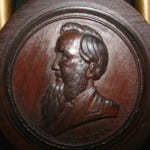The History of the Estey Organ Company
Expanding Silence: The Rise and Fall of the Estey Organ Company
 Jacob Estey founded the Estey Organ Company in 1846 in Brattleboro, Vermont. Estey could sense a change in the American people, and was anticipating a shift towards a more music-centric society. When the company was first started, they specialized only in reed organs until 1901, when they hired a new organ builder and opened up a pipe organ branch. Before this time, organs were hardly ever manufactured in the United States (less than 300 reed organs were assumed to have been made there). So, just by getting into the organ business, Estey not only introduced his specific organs to America, but American organs in general. Estey has also been an internationally known business since the early 1900s, and their organs have been sent to Australia, Africa, and Europe. Given the great international demand for these organs, it is no surprise that at the height of their production, the Estey Organ Company’s complex consisted of 30 different buildings and was the largest organ factory in the world. According to their website, the company built over three thousand pipe organs from 1901 to the company’s closing. In addition, they also sold over 500,000 reed organs.
Jacob Estey founded the Estey Organ Company in 1846 in Brattleboro, Vermont. Estey could sense a change in the American people, and was anticipating a shift towards a more music-centric society. When the company was first started, they specialized only in reed organs until 1901, when they hired a new organ builder and opened up a pipe organ branch. Before this time, organs were hardly ever manufactured in the United States (less than 300 reed organs were assumed to have been made there). So, just by getting into the organ business, Estey not only introduced his specific organs to America, but American organs in general. Estey has also been an internationally known business since the early 1900s, and their organs have been sent to Australia, Africa, and Europe. Given the great international demand for these organs, it is no surprise that at the height of their production, the Estey Organ Company’s complex consisted of 30 different buildings and was the largest organ factory in the world. According to their website, the company built over three thousand pipe organs from 1901 to the company’s closing. In addition, they also sold over 500,000 reed organs.
A particularly revolutionary Estey invention was the children’s reed organ, which was developed in the 1920s. Previously, children had a difficult time playing organs because they were not tall enough to both play the keys and push the foot pedals. Estey began producing miniature organs that were suitable for children, thus allowing the organ to be an instrument that could be played from early on in one’s life.
The Estey Organ Company–like any corporation–was troubled by numerous financial issues, starting in 1933. The company went bankrupt due to the Great Depression’s effect on the organ market, and the fact that they did not lay off any employees during that time. In order to stay in business, the company was sold until ownership was reclaimed in 1949. By 1953, the company started to begin its final decline when it was bought out by Rieger Organ, Incorporated. Under Rieger, the company attempted to keep up with the changing technology and introduced a line of electronic organs, only to go bankrupt once more in 1959. They managed to open the company a year later under the name Estey Electronics, Incorporated, and in a last attempt to save the company, came out with new reed chord organs. They finally went out of business in 1960.
While there is both a virtual museum and a physical museum honoring the Estey Organ Company’s 115-year run, finding an in-use Estey organ is becoming harder and harder. The people involved in maintaining Estey organs (like Messrs. Czelusniak et Dugal, Inc., of Northampton) are–like the organs themselves–few and far between. Those who work with and cherish Estey organs seem to be familiar with each other—so, while the community is a small one, it is certainly one of value. It’s clear that the Estey Organ Company’s history is one full of struggle, gradual disappearance, and sporadic revival, which is paralleled in the remaining organs themselves. Because of this, the Estey Organ Company and their products are valued and remembered for their reputation as great instruments and because they serve as historical artifacts.
